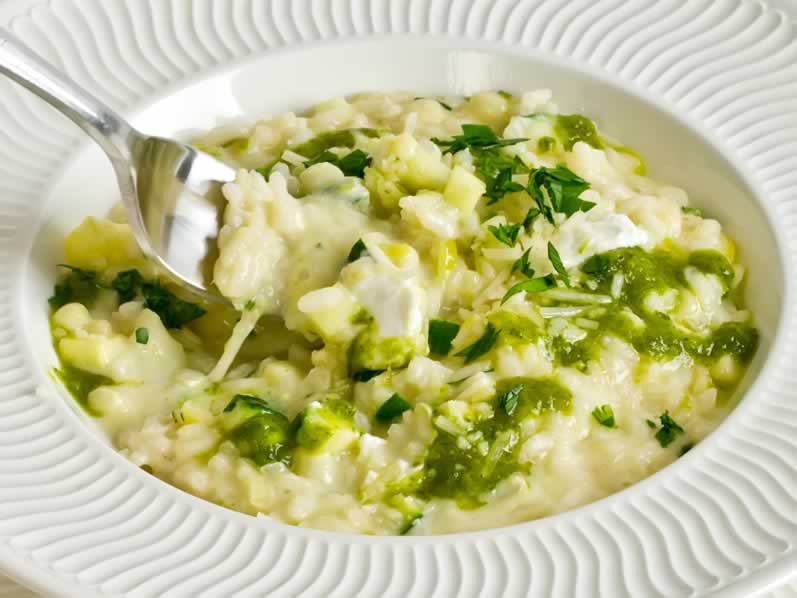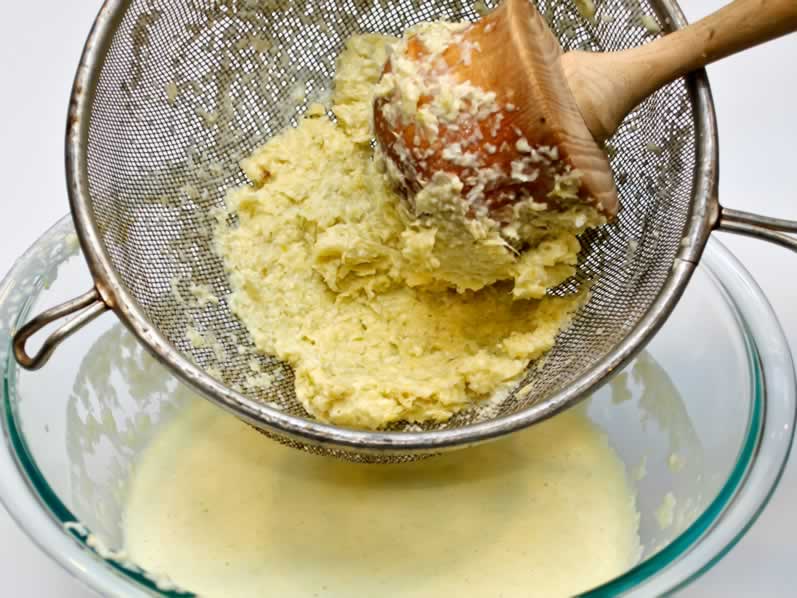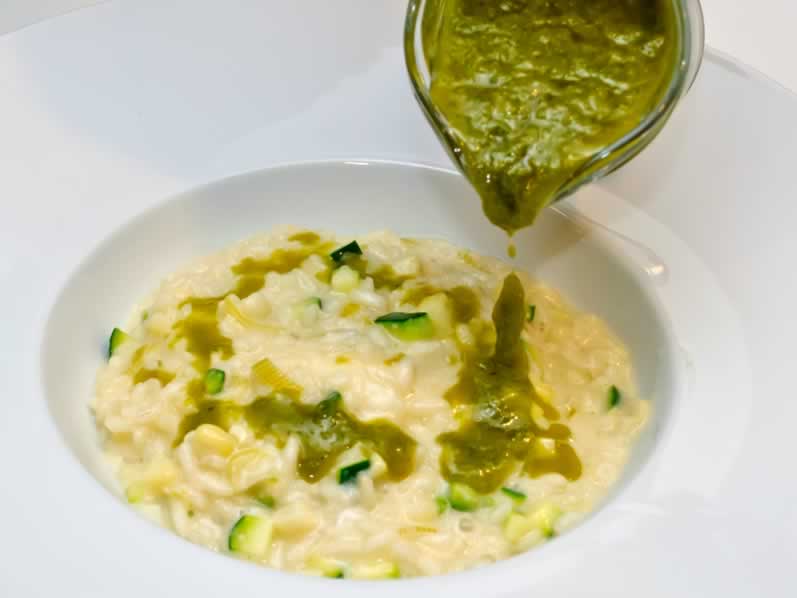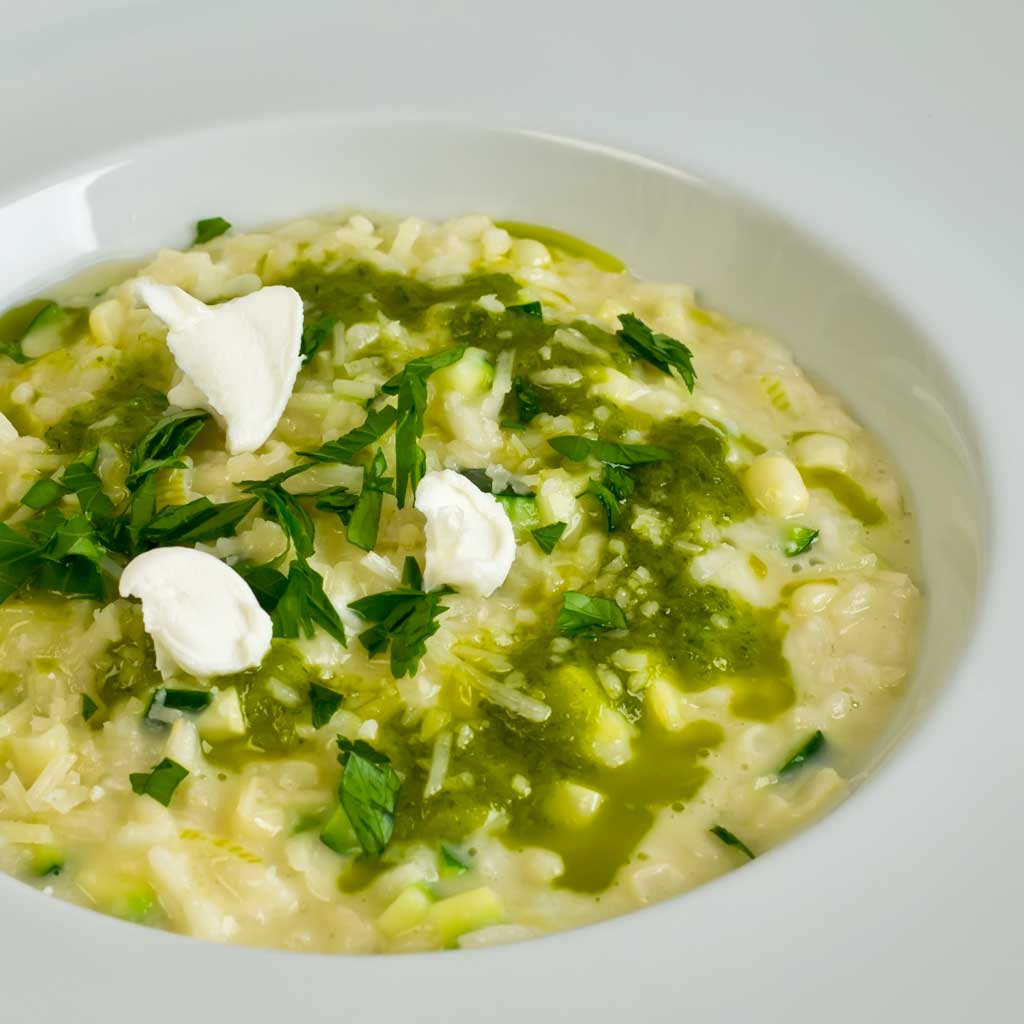If there is an easier, quicker, more elegant, more economical, more versatile, more satisfying dish in the world than risotto, I can’t think of what it might be.
As long as you keep premium-quality risotto rice on hand, you will certainly have something in the frig to complete the dish. That something can be almost any combination of fresh or cooked vegetables, meats, seafood, fresh herbs, and cheese.
At the very simplest end of the spectrum, however, you need nothing more than butter, rice, stock, a small amount of grated Parmesan, and salt. If you want to gild the lily, there is plenty of latitude for that as well, to which the recipe below attests.
RELATED: MORE LUNACAFE CORN RECIPES.
But before diving in, here’s a review of time-honored tips and tricks that will ensure the best risotto ever.
Tips & Tricks for the Best Risotto
- Use short-grain, high-starch rice, such as Italian arborio superfino, carnaroli, or vialone nana. These varieties are somewhat sticky when cooked. Carnaroli is the favorite risotto rice of many chefs. It is the stickiest of the three, absorbs a lot of liquid, does not overcook quickly, and produces a creamy, flowing risotto.
- Use a double rich or partially reduced chicken or vegetable stock. The stock is the flavor carrier for this dish. It must taste superb on its own.
- Use a dry white wine as the first liquid addition. It adds acidity to balance the rich, creaminess of the risotto, and depth as well. The alcohol will cook off in minutes when you add the wine to a very hot pan. However, if you are alcohol intolerant, consider adding a tablespoon or so of lemon juice at the completion of the risotto. It adds a lively note.
- The amount of liquid specified for risotto is always variable. Have extra on hand, in case the rice demands it.
- Allow 5 minutes to toast the exterior on the rice in the initial fat. If the exterior of each rice kernel is not sealed, the risotto will glom together in a sticky mass.
- Don’t work too hard. For the first 15 minutes or so of the cooking time, you will need to stir the pan only occasionally with a flat edged wooden spoon. The goal is simply to keep the rice from sticking to the bottom of the pan and to check the amount of liquid remaining. After 15 minutes, stir almost continuously (but leisurely) to encourage the rice kernels to release some of their starch into the liquid, creating a creamy sauce in the process.
- Don’t walk away from the risotto during the final 10-15 minutes of cooking. It will stick to the bottom of the pan and burn without frequent additions of liquid.
- Although you will find advice to the contrary, in my tests, it made no difference whether the stock was hot, warm, or room temperature. The pan is very hot and the amount of stock you add at any one time is small, thus the stock heats almost instantly upon hitting the hot pan and rice.
- Always add the stock in ½-cup increments, allowing rice to absorb nearly all of it before adding the next amount. If you are new to making risotto, add ¼ cup increments during the final 10-15 minutes, to avoid inadvertently flooding the rice with liquid just as it completes cooking.
- Cook the rice slowing and steadily, taking a full 20-30 minutes in the process. The liquid should be gently bubbling at all times.
- Test for doneness frequently during the final 10 minutes of cooking. When fully cooked, the rice will be doubled in size, chewy, and slightly firm at the center. Al dente is the term most often used to describe the desired texture.
- For perfect results, stop cooking the rice while it is still firm to the tooth and a little soupy. The rice will finish cooking during the 3-5 minutes it takes you to add the cheese and butter and serve.
- Always taste and season the risotto before serving. It will need salt.
- Adding cheese and either butter or olive oil at the very end enhances the creaminess of the risotto.
- Risotto should be creamy and very moist. It should not hold its shape in a mound on the plate, but spread out somewhat. The final addition of cheese to the risotto thickens it considerably, thus the risotto must be on the loose side before the addition of the cheese to compensate.
- Because the risotto should spread out on the plate, it is most attractive served in a pasta-type bowl with a small indent and wide rim. The bowl-like indent contains the rice in a definite shape, while the wide rim provides drama for the simple dish.
Now for the basic process. Master these easy steps and basic proportions, and you can create hundreds of different risottos, all without a recipe.
Basic Risotto Process
When you understand the basic risotto process, you can create endless riffs with ingredients you happen to have on hand.
- In a large saute pan, saute chopped onion, shallots, or leeks in butter until softened but not browned.
- Add short-grained rice, such as Arborio or Carnaroli, and stir to coat each grain with butter. Toast rice for 3-5 minutes without browning.
- For the first 15 minutes, add liquid in ½-cup increments, maintaining a steady simmer and allowing rice to absorb each increment before adding the next. Stir periodically and leisurely, just to keep the rice from sticking to the bottom of the pan.
- For the final 15 minutes, add liquid in ¼-cup increments, continuing to stir leisurely, but more continuously, which encourages the rice to release starch into the liquid. Regulate the heat to maintain a steady (not wild) simmer. Ideally, the risotto will be perfect (al dente) at the 30-minute mark. (If you cook it too quickly, it will be soft on the outside and chalky on the inside. If you cook it too slowly, it will be mushy.)
- During the final 5 minutes of cooking, if desired, add cooked ingredients of choice 9or ingredients that will cook in under 5 minutes).
- Add Parmesan and butter, and stir.
- Immediately ladle risotto into warm serving bowls, and serve.
Basic Risotto Proportions
It doesn’t get much more basic than this: 2 tablespoons butter, 1 chopped onion, 2 cups risotto rice, 6-8 cups stock, ½ cup Parmesan, and salt to taste.
Using Leftover Risotto
I can’t image cooking only enough risotto for 2 servings, the usual number of people dining at our house. I love the leftovers as much as the original meal. The starchiness of risotto makes it the perfect choice for any number of fried goodies, such as Arancini di Riso (breaded, fried risotto cakes) and Riso al Salto (fried risotto balls). You can also add leftover risotto to a rice tian or quiche filling.
Risotto of Sweet Corn with Corn Coulis, Zucchini, Chevre & Green Chile Oil
This divine risotto is redolent with sweet corn, the result of using a creamy corn coulis as part of the liquid. Fresh corn and diced zucchini add textural interest, while a young chevre contributes depth and silkiness to the sauce. A finishing drizzle of Green Chile Oil provides color and flavor counterpoints.
Advance Prep: You can make the Green Chile Oil and Sweet Corn Coulis a day or two ahead if you like.
Green Chile Oil
1 poblano chile, stemmed, seeded, ribbed, and chopped (wear disposable gloves)
1 serrano chile, stemmed, seeded, ribbed, and chopped (wear disposable gloves)
1 clove garlic, minced or pressed
½ cup chicken or vegetable stock (or water)
¼ cup cold-pressed, extra-virgin olive oil
fine sea salt, to taste
Sweet Corn Coulis
1 tablespoon unsalted butter
2 medium leeks, white and pale green portions only, chopped (Set aside ½ cup.)
4 ears fresh corn, shucked (3 cups kernels; reserve 1 cup for risotto)
2 cups corn kernels, from above
2 cloves garlic, peeled and minced or pressed
3/4 cup cream
fine sea salt, to taste
Stock
6 cups chicken or vegetable stock
stripped, broken cobs from 4 ears of corn, from above
Risotto
2 tablespoons unsalted butter
½ cup chopped leeks, from above
1 clove garlic, peeled and minced or pressed
2 cups Italian Carnaroli or Arborio rice
½ cup dry white wine, optional
4 cups reduced chicken or vegetable stock, from above (plus 1-2 cups more as needed)
1 cup corn kernels, from above
1 small zucchini, trimmed and diced
fine sea salt
freshly ground white pepper
½ cup fresh, creamy chevre
¼ cup finely grated Parmesan
Garnish
2 tablespoons chopped flat-leaf parsley
¼ cup finely grated Parmesan
- To make the Green Chile Oil, in a small saucepan, add the chiles and stock. Cover and simmer just until tender, about 5 minutes. Remove from the heat, pour off any remaining liquid, and add chiles to a processor bowl fitted with the steel knife. Add the garlic and pulse until fairly smooth. Add olive oil and process until smooth and well combined. Season to taste with salt. Reserve.
- To make the Corn Coulis, hold the corn upright by the stem and steady the tip against a cutting board. Use a small paring knife to scrape the kernels from the cob with a downward motion. You should have about 3 cups of kernels. Set aside ½ cup of leeks. Reserve the corncobs.
- In a medium saute pan, heat 1 tablespoon butter and saute the remaining leeks and 2 cloves garlic until well softened but not browned.
- Add 2 cups corn and cook until tender, about 3 minutes. Add cream and stir to combine
- In a processor fitted with the steel knife, puree the coulis as smoothly as possible.
- Pour the coulis into a triple mesh sieve set over a mixing bowl and force the liquid through the mesh using the back of a large spoon or a wooden pestle. Discard the roughage left in the sieve. Season the coulis to taste with salt. Reserve.
- To infuse and reduce the stock, snap the stems off the corncobs and break each cob into 3-4 pieces.
- Put the stock into a large saucepan and add the corncobs. Bring to a simmer and reduce by 1/3. You should have 4 cups of reduced stock. Remove from the heat.
- To make the risotto, melt 2 tablespoons butter in a heavy-bottomed casserole or large saute pan. Add ½ cup reserved leeks and garlic, and saute over medium heat until tender but not browned.
- Add the rice and stir to coat each grain with butter.
- Over medium heat, add the wine, if using, and cook, stirring continuously, until nearly all has evaporated.
- Begin adding the stock, 1/2 cup at a time, letting it nearly evaporate before adding more. The liquid should be simmering gently, not uproariously.
- At about the 15 minute mark, when the rice is becoming tender but still quite firm at the center, begin adding the Corn Coulis, ½ cup at a time. Begin stirring continuously now, to encourage the rice to release some of its starch into the sauce.
- Five minutes before the risotto is done, add the corn and zucchini, and stir in.
- In a perfect world, the rice will be just right—tender but toothsome—as you add the last drop of coulis. However, if this is not the case, simply add more stock until the correct consistency is achieved. I prefer risotto to be on the saucy side, but you can decrease the amount of liquid by cooking a minute or two longer. The risotto should be fully cooked–tender with some bite–in 20-30 minutes.
- Season to taste with salt and pepper.
- Quickly stir in the chevre and parmesan.
- Immediately ladle the risotto into warm serving bowls. Drizzle chile Oil over each serving and garnish with parsley and additional parmesan.
Serves 4-6.
Resources
- Coconut & Lime: Two Ways to Use Up Leftover Risotto: Riso al Salto and Arancini di Rosa
- Cook Italy: Heart of Heart Risotto
- Eatmania: Rice for Risotto: Carnaroli and Vialone Nano
- Fine Cooking: Risotto: Elegant Comfort Food
- Fine Cooking: Beyond Arborio: Discovering the ‘Other’ Risotto Rices
- Food Endeavors of the Blue Apocalypse: Using Leftover Risotto to Make Fritters
- Hub Pages: Carnaroli: The Best Rice for Risotto
- New York Times: Risotto Aggrandized
- SFGate: Risotto Revelation: Three Divergent Italian Rices are Challenging the Reign of Arborio
I Love Hearing from You!
If you have read this far, please leave a comment. Include your blog URL and CommentLuv will automatically link back to your most recent blog post. Also join LunaCafe on Facebook for daily adventures in the OtherWorldly Kitchen. I appreciate your support more than I can say. Blessings…Susan
Copyright 2012 Susan S. Bradley. All rights reserved.








I really loved the use of the corn and the chili oil. Your pic is beautiful. Thx for submitting. I featured your recipe on the Friday Five – Risotto addition at Feed Your Soul Too – http://www.feedyoursoul2.com/2013/10/friday-five-risotto-addition.html
Thank you, Peter!
Good. I have a bag of corns so the next step will buy all the other ingredients and follow your steps. The photos makes it more delicious.
Soozie: As always your work is the best I’ve ever seen. Are you thinking of another cookbook? I just love your first one on NW Cuisine and expecially your comments about “family” in the intoduction. Love to all Grandma, Cousin Casey
Casey, so good to hear from you, darling cousin. Are you on Facebook? You can find me there as Susan S. Bradley or LunaCafe. I would love to keep up with you. Grandma is in my thoughts daily. In fact, I think she follows me around the OtherWorldly Kitchen, advising me to add this or that. She loved the Pecan Pie I made yesterday. The lemon was her idea.
Are you on Facebook? You can find me there as Susan S. Bradley or LunaCafe. I would love to keep up with you. Grandma is in my thoughts daily. In fact, I think she follows me around the OtherWorldly Kitchen, advising me to add this or that. She loved the Pecan Pie I made yesterday. The lemon was her idea. 
You read my mind it appears. I am working on a second book, and it’s a radical departure from the first. I am trusting “The Muse” on this one, as I would not have chosen this topic on my own. It’s pure fun, which turns out to be highly necessary to keep me working after putting in 8-12 hours on the DAY JOB front. Can’t divulge the theme yet, but soon, soon…
Yummmm!!!!!!!!!!!
Rachel, you must make this. It’s easy and vegetarian too.
Delicious recipe!Hmmm it looks yummy my stomach aches when I see your post. I love cooking and discovering new recipes. I always want it new, healthy and palatable to taste. And I find your featured recipe perfect! I’l try this at home.:)
Thank you, Vera!
This looks like an interesting recipe. The photos on here are amazing. Keep up the great work! I’m off to go get something to eat, haha.
Thank you, Bob!
Oooh, this sounds so lovely!
What a beautiful recipe!
I love this. I am a local chef here at our region and do specializes at seafood menus. I might as well add some crabs on this one. Might experiment a bit. You have given me an idea!
